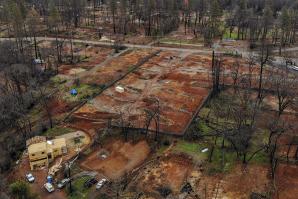It looks a bit like the Oscars. A man in a tuxedo presents the awards. A crowd erupts in applause. Then Sacramento Mayor Darrell Steinberg comes on screen, holds a white construction helmet and gives a brief speech. “Now, more than ever, it is important to dream big as we turn the page of history to design, to engineer and to construct our future,” he says. “Congratulations.” Checks made out to high school and college students appear — it’s scholarship money for them to pursue careers in the construction industry.
And this all happened during the stay-at-home order caused by the coronavirus pandemic.
The May 7 awards ceremony for the Design Build Competition, hosted by the Sacramento Regional Builders Exchange (an industrial and commercial construction association known as SRBX), like the competition itself, was supposed to be in person. Then COVID-19 forced it to become virtual. The applauding crowd in the video was footage from long-ago Academy Awards ceremonies. The checks were shown on-screen. Everyone spoke from their home or office.
The man in the tuxedo was Jordan Blair, executive director of the association’s Education Foundation, who felt the program must go on, because the need is urgent. “The construction industry has a lot of baby boomers retiring in rapid numbers,” says Blair. “Even after COVID-19 resolves, we’re still going to have a labor shortage.” This exodus of boomers — what some call a “silver tsunami” — is a generational shift that presents the industry with both stubborn challenges and surprising opportunities, which the COVID-19 pandemic accelerates.
The Silver Tsunami
For every five older construction workers ready to retire, says Blair, there is only one person with formal training ready to take their spot. The labor crunch is across the board. According to a 2019 survey from the Associated General Contractors of California, the toughest jobs to fill were installers (71 percent said it was more difficult to fill the position in 2019 than the previous year), plumbers (70 percent), pipelayers (70 percent), roofers (67 percent), and heavy-equipment and crane operators (67 percent). “The shortage is absolutely industrywide. You pick it,” says Allison Otto, executive vice president at Otto Construction in Sacramento, which builds primarily public works like schools, libraries and hospitals.
“The construction industry has a lot of baby boomers retiring in rapid numbers. Even after COVID-19 resolves, we’re still going to have a labor shortage.”
Jordan Blair EXECUTIVE DIRECTOR, EDUCATION FOUNDATION, SACRAMENTO REGIONAL BUILDERS EXCHANGE
The problem is twofold: Boomers are retiring, and construction doesn’t strike many 18-year-olds as an obvious career choice. “Now tech is the cool new thing,” says Katherine Bardis-Miry, cofounder of Bardis Homes in Sacramento, adding that 30 years ago, there simply weren’t as many career options. “This is not exactly the easiest industry to wake up one day and say, ‘I’m going to be a developer!’” Bardis-Miry says this is why you see so many second- and third-generation construction workers (like herself and Otto); for many, the main way they learn about the industry is through family.
The silver tsunami causes other problems besides a labor gap. “When a senior exec retires, it’s difficult to backfill their position,” says Melanie Okoro, CEO of Sacramento-based Eco-Alpha Environmental and Engineering Services. “There’s not always a transition of knowledge, so it’s hard to retain that knowledge and keep it within the organization.” This can be especially vexing in the construction industry, which has problems that just can’t be solved by software, apps or algorithms. Hands-on experience matters.
“There are aspects of the industry where machines can’t build certain parts,” says Josh Twist, president of Sacramento-based TNT Industrial Contractors, citing the example of infeed and discharge fittings for can conveyors on a manufacturing plant, which have to be custom-made by hand. This is a skill that was once passed down from master to apprentice, generation to generation. “There are not many people around who really know that type of work,” says Twist. “The older generation has a lot of knowledge with welding.” At TNT, he tries to solve this problem by pairing the younger workers with the old-timers.
Different generations have different values. “It used to be, ‘My way or the highway!’ But there has been a huge shift,” says Otto, as millennials and Generation Z (people born roughly around 1995-2010) demand more of a work-life balance. Millennials want the flextime that allows them to pick up their kid from school, coach their daughter’s T-ball team or make the PTA meeting. They want more vacation time, more autonomy and more of a sense that their work matters to society.
“The new generation wants more social justice,” says Blair. “They’re asking, ‘What is the company doing to make the world a better place?’” They are more likely to consider the social impact of their projects and clients. Are you building a hospital? Are you curing illness? Are you building a courthouse that will serve social justice?
The construction industry offers what Gen Z and millennials say they want — which includes, ideally, less crushing student debt. “The viability of our career path is so underappreciated in the masses,” says Erin Volk, Associated General Contractors of California’s vice president of workforce and community development.
In focus groups with the parents of high school students, AGC hears that construction jobs are underpaid, dangerous and lack stability. “In reality, it’s the exact opposite,” she says, adding that high school graduates can earn $60,000 to start and six figures within five years. “Gen Z is focused on career path, stability and community impact, and they’re watching their Gen X parents carrying all that college debt,” says Volk.
The mission of organizations like the AGC of California, the Building Industry Association and SRBX is to show Gen Z that construction is a career path that’s legitimate and lucrative. The AGC’s Build California program, launched in 2019, gives high school students tools and resources to land a job in the industry. The pitch isn’t subtle: Build California’s website cuts to the quick, using large, bold graphics to show the competitive hourly wages: $36 per hour for cement masons, $41 for ironworkers, $42 for electricians and so on.
SRBX, founded in 1901, tries to shore up the workforce pipeline with mentoring programs, educational classes about the trades and, perhaps most significantly, the Design Build Competition (which culminated in the online awards ceremony). Normally, high school students show off their construction skills in person through a competition in March and April to build tiny homes, sheds or storage structures. Then came COVID-19.
At first, SRBX thought about scrapping the event — it’s impossible to build a shed online. How do you swing a virtual hammer? Then they heard from self-isolated teachers that the students could use a distraction. So Blair and SRBX whipped up a virtual program, where the students would do things at home, like design a tiny house that can be built for the survivors of the Camp Fire in Paradise, and then build a physical model from materials they scrounged up from around the home, like boxes of macaroni and cheese. “We’re not trying to fool anyone, it’s not a full replication,” says Blair. “But it’s been awesome.”
Design Build usually attracts around 500 students, so SRBX hoped it would get maybe 100 for the online-only version. It was wildly off; the final tally was 621. “Thank you,” Steinberg says in the virtual award ceremony. “Thank you for not giving up on this year’s competition. … Thank you for being there for those students when they needed you the most.”
The Silver Lining
The generational shift has a sneaky upside: adoption of tech. “The construction industry is not a leader in innovation,” says Otto. “We’re always lagging just a little bit behind.” Compare the laptops of 2020 to the personal computers of the 1980s, and then do the same thing for homes. “The way your house is built hasn’t changed,” says Bardis-Miry. “You still pour your foundation. You frame your walls. You do your electrical.” The homes themselves can be a little different, and they’re built more eco-friendly, and perhaps they use different materials, but Bardis-Miry says, “The basic structure and foundation hasn’t changed. Because of that, people are slow to react and want to do new things. We’re a very old industry that rarely gets shaken up.”
The construction industry has many moving parts, with layer upon layer of management. This adds to the challenge of tech adoption. “Even if the general contractor buys into the new tech,” says Bardis-Miry, “this doesn’t mean that the electrical subcontractor is willing to use it or train his people to use it. They’ll say, ‘This is something new. Let’s just go back to using a fax machine.’” Twist agrees, “Just getting the old-timers to computers, that’s the hard thing. They want to use paper and pencil.”
Gen Z and millennials are more likely to embrace new tech and new ideas, such as digital and virtual design schematics. “For a lot of the buildings built 30 or 40 years ago, you do your paper plans, but then all of a sudden, when you put in your plumbing and electrical, there’s not enough space,” says Blair. “Now … you can do your spacing down to a 10th of an inch.” That slashes both costs and time.
Or take scheduling software, which allows a general contractor to juggle the management of subcontractors. Or drones. Otto Construction now uses a Maverick drone to feed project managers information they couldn’t typically see from the ground. The drone has been used to verify damage caused by a fire from an adjacent building, assess the condition of a historic roof the company couldn’t access and snap photos that can be used for documentation to help future planning.
COVID-19 has accelerated some of this tech adoption. At least in the first few months of the pandemic, according to the industry executives, construction has been less affected than most other sectors, because it was deemed an essential service. Workers continued mixing cement, installing sheetrock, laying pipes. Twist says the workers found social distancing to be challenging (how do you stay 6 feet apart from someone simultaneously working on a tiny roof?), and safety precautions slowed building progress (such as frequently sanitizing shovels, wrenches and tractor steering wheels), and an overall feeling of anxiety sapped productivity. “There was a worrisome attitude of people asking, ‘What’s going to happen? Is this thing going to kill us all?’” says Twist.
Yet, the industry also discovered some efficiencies. “We’re learning new tips and tricks,” says Bardis-Miry, citing the use of Zoom to conduct video tours of homes for sale. This has gone so smoothly, Bardis Homes will continue the practice after the pandemic.
Otto Construction also has a newfound appreciation for team-collaboration software. “We’ve always had access to Microsoft Teams but never used it,” says Otto. “Now, we love it. This was never our first choice, but we were kind of forced into it, and we learned how user-friendly it is, and it has been great.”
Another silver lining of COVID-19, says Twist, is a willingness to shift to electronic paperwork for such things as bids and permits. Many of TNT Industrial’s projects are for public works (such as Sacramento’s water treatment plants) that required the company to submit paper bids in person, so the company spends hours driving to locations across the state. COVID-19 has forced this to be done digitally. “That’s one thing I hope comes out of this,” says Twist. “Some of these old-school ways of doing things can be changed.”
And if that change doesn’t happen today, it’s likely to happen tomorrow. Just ask the 621 competitors of the Design Build Competition, who will, quite literally, be building our future.
—
Get stories like this delivered to your inbox: Subscribe to the Comstock’s newsletter today.
Recommended For You

Business as Usual in Homebuilding
Construction workers are considered ‘essential’ in California’s shelter-in-place order
Across the Capital Region, construction continues as usual on housing, infrastructure and other projects, even as workers in other sectors shelter at home.

Higher Calling
Architects and colleges collaborate to create holistic, functional and artistic spaces to meet the shifting needs of today’s students
These six Capital Region higher-education projects, completed in the last decade, offer inspired and intentional learning spaces.

Building On
Wendy Cohen of Kitchell talks about the construction firm’s projects underway in Sacramento
Construction is one industry that has continued through shelter-in-place orders. Comstock’s spoke with Wendy Cohen, vice president of operations for the construction firm Kitchell, to learn how the industry has been impacted by the coronavirus and the role it can play in the recovery.

Building Resiliency
Updated building codes have helped save homes during wildfires, but should California do more?
2.7 million residents live in areas with a high risk of wildfire, and the scarcity of urban real estate pushes construction toward the wooded areas most likely to ignite. Should this be allowed?





Comments
This is what I have been telling the 20-somethings that I know for the last couple of years. As a construction manager, I know we need quality workers and the pay, in some cases, is even better than I make! No student loans and pensions for retirement are just a couple of the benefits